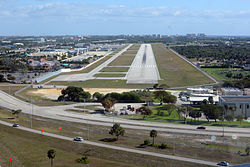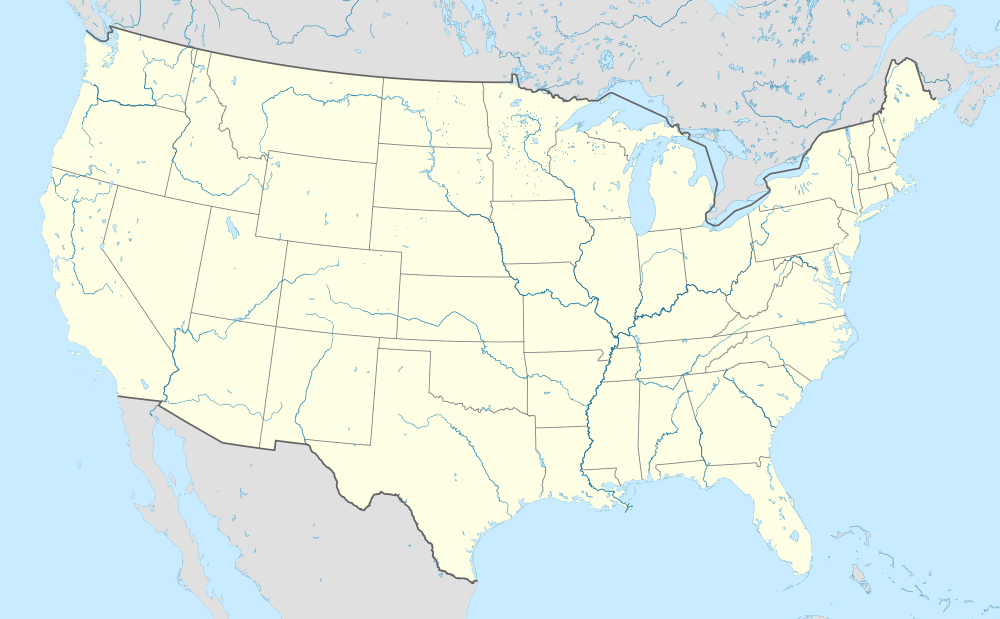Boca Raton Airport
Boca Raton Airport | |||||||||||
|---|---|---|---|---|---|---|---|---|---|---|---|
 Runway 5 on final approach | |||||||||||
| Summary | |||||||||||
| Airport type | Public | ||||||||||
| Owner | State of Florida | ||||||||||
| Operator | Boca Raton Airport Authority | ||||||||||
| Serves | Greater Miami | ||||||||||
| Elevation AMSL | 13 ft / 4 m | ||||||||||
| Coordinates | 26°22′43″N 080°06′28″W / 26.37861°N 80.10778°W | ||||||||||
| Website | www | ||||||||||
| Maps | |||||||||||
 FAA airport diagram | |||||||||||
 | |||||||||||
| Runways | |||||||||||
| |||||||||||
| Statistics (2018) | |||||||||||
| |||||||||||
Boca Raton Airport (IATA: BCT, ICAO: KBCT, FAA LID: BCT) is a state-owned public-use airport located two miles (3 km) northwest of the central business district of Boca Raton, a city in Palm Beach County, Florida, United States.[1] The airport is immediately adjacent to Florida Atlantic University and to Interstate 95.[2]
Boca Raton Airport is publicly owned and is designated as a general aviation transport facility governed by a seven-member Authority appointed by the City of Boca Raton and Palm Beach County Commission.[2]
Facilities and aircraft
[edit]
Boca Raton Airport covers an area of 214 acres (87 ha) and has one asphalt-paved runway designated 5/23, which measures 6,276 × 150 ft (1,913 × 46 m).[1] The airport has a control tower which is staffed from 7:00 a.m. to 11:00 p.m. There are two full-service fixed-base operators, Signature Flight Support and Atlantic Aviation. The Burton D. Morgan School of Aeronautic of Lynn University is located at the airport.[2]
For the 12-month period ending December 31, 2020, the airport had 81,550 aircraft operations, an average of 223 per day: 93% general aviation, 6% air taxi and <1% military. At that time there were 242 aircraft based at this airport: 130 single-engine, 27 multi-engine, 82 jet and 3 helicopter.[1]
History
[edit]Beginnings
[edit]- See Boca Raton Army Airfield for the military use of the airport during World War II
Boca Raton Airport was established in 1936. In 1941, in response to the emerging Axis threat, the United States began to rapidly mobilize and expand its armed forces. In addition to enlarging its Army and Navy, the US also sought to expand its air forces. The service we know today as the U.S. Air Force was known prior to June 1941 as the U.S. Army Air Corps and after June 1941 as the U.S. Army Air Forces, and was a subordinate branch within the U.S. Army. To expand the air corps/air forces, new air bases were established throughout the United States, including bases in southern Florida at Homestead, Morrison Field in West Palm Beach, and Boca Raton Airport.[3]
Boca Raton Airport, also known as Boca Raton Army Airfield, was selected to house a military airfield for a number of geographic and practical reasons. Southern Florida's climate and physical geography are generally considered mild compared to most northern locations. Florida experiences a winter climate characteristic of the subtropics. Lacking snow or low temperatures enabled military operations to continue year round. Florida also has consistently flat terrain, an ideal feature when training new and inexperienced pilots. Its location adjacent to the Atlantic Ocean and the Gulf of Mexico also provided ideal locations for flight training. Boca Raton was also chosen for practical purposes. In the early-1940s, Boca Raton's population numbered only 723. This enabled the United States government to take thousands of acres of land for its use without having to relocate a large number of people. However, this is not to say that the establishment of the military airfield was without controversy. A majority of the land was acquired from Japanese American farmers from the failing Yamato Colony, the land having been seized through the process of eminent domain, leaving many Japanese Americans little recourse in the early days of World War II.[4] All of these conditions enabled construction of the military airfield to commence in June 1942.[3][5]
After World War 2
[edit]While most of the Boca Raton Army Air Field was deactivated in 1946, more than 800 acres (3.2 km2) were retained as the Boca Raton Air Force Auxiliary Field. Another 85 acres (0.34 km2) were used in the 1950s for a secret project to produce stem rust spores for possible use as a biological agent against wheat production in the Soviet Union. Other parts of the World War II air base were returned to private ownership and developed. In 1959 the remainder of the base was turned over to the City of Boca Raton and to the State of Florida. 200 acres (0.81 km2) and a single runway (of three original runways), completely rebuilt, became Boca Raton Airport. The remaining land became the campus of Florida Atlantic University.[3][6]
Recent history
[edit]The airport's first control tower opened in 2000. The tower was named after Philip Modder, who was the Chairman of the Boca Raton Airport Authority. Philip “Phil” Modder had pushed for Boca Raton, with its growing traffic of corporate jets, to have its own tower.[citation needed]
The airport suffered more than $12 million worth of damage to hangars when Hurricane Wilma passed through the area in October 2005.[7][8]
In 1997, the restored original Aston Martin DB5 "Effects Car" from the James Bond film "Goldfinger" was stolen from a hangar at Boca Raton airport.
A U.S. Customs and Border Protection facility was scheduled to open in 2017 in order to allow Boca Raton Airport to process passengers arriving on international flights.[9] Boca Raton Airport's Customs and Border Protection facility opened in May 2018.[10]
Major accidents at or near BCT
[edit]- On August 8, 1956, a Sky Spray Fairchild C-82 Packet returning from a spraying mission experienced smoke coming from the #2 engine and a loss of power from the #1 engine on final approach to then Boca Raton Air Force Auxiliary Field. The aircraft in a banking manoeuvre lost control and crashed. All 5 occupants (2 crew, 3 passengers) died.[11]
- On June 23, 2000, a Universal Jet Aviation Learjet 55 on a Visual flight rules (VFR) climb from BCT collided at an altitude of 2,400 feet 2.8 miles SW of Boca Raton with an Extra EA-300S which took off from Pompano Beach Airpark. Both aircraft crashed to the ground. All 3 occupants (2 crew, 1 passenger) on the Learjet 55 were killed along with the sole occupant of the Extra EA-300S.[12]
Airline and destinations
[edit]| Airlines | Destinations | Refs. |
|---|---|---|
| JSX | White Plains Seasonal: Morristown | [13] |
| Destinations map |
|---|
All charter destinations from Boca Raton Airport |
See also
[edit]References
[edit]- ^ a b c d FAA Airport Form 5010 for BCT PDF, effective December 31, 2020
- ^ a b c Boca Raton Airport Authority URL retrieved April 5, 2006
- ^ a b c "The History of the Boca Raton Airport". Boca Raton Airport Authority. Archived from the original on 2010-01-23. Retrieved 2006-10-21.
- ^ "The Yamato Colony: Japanese Pioneers in Florida". The Morikami Museum and Japanese Gardens. Retrieved 2006-11-04.
- ^ "A Journey Through Boca Raton: Timeline 1895 — 1999". Boca Raton Historical Society. Archived from the original on 2013-04-14. Retrieved 2006-10-21.
- ^ "U.S. Military in Boca Raton - Post-War Military Secrets". Palm Beach County History Online. Historical Society of Palm Beach County. Archived from the original on 5 April 2023. Retrieved 17 October 2023.
- ^ Moore, S. Clayton. "Avitat Boca Raton Brings the Wow Factor to FBO Management". Airport Journals. Archived from the original on July 7, 2011. Retrieved December 15, 2007.
- ^ Valdemoro, Tania. "Boca Airport Damage Hits $12 Million". Palm Beach Post. Retrieved December 15, 2007.
- ^ Sun-Sentinel, South Florida. "Boca Raton upgrading its airport". Sun-Sentinel.com. Retrieved 2016-04-22.
- ^ "Pilot Praises CBP Facility for Fast, Efficient and Friendly Service" (press release). Boca Raton Airport. June 4, 2018.
- ^ Accident description for N4832V at the Aviation Safety Network. Retrieved on January 21, 2021.
- ^ Accident description for N220JC at the Aviation Safety Network. Retrieved on January 21, 2021.
- ^ "JSX Adds Morristown / Boca Raton Service From late-Dec 2023". Aeroroutes. Retrieved 19 October 2023.
External links
[edit]- Boca Raton Airport Authority
- "Boca Raton Airport". brochure from CFASPP
- FAA Airport Diagram (PDF), effective November 28, 2024
- FAA Terminal Procedures for BCT, effective November 28, 2024
- Resources for this airport:
- FAA airport information for BCT
- AirNav airport information for KBCT
- ASN accident history for BCT
- FlightAware airport information and live flight tracker
- NOAA/NWS weather observations: current, past three days
- SkyVector aeronautical chart, Terminal Procedures

